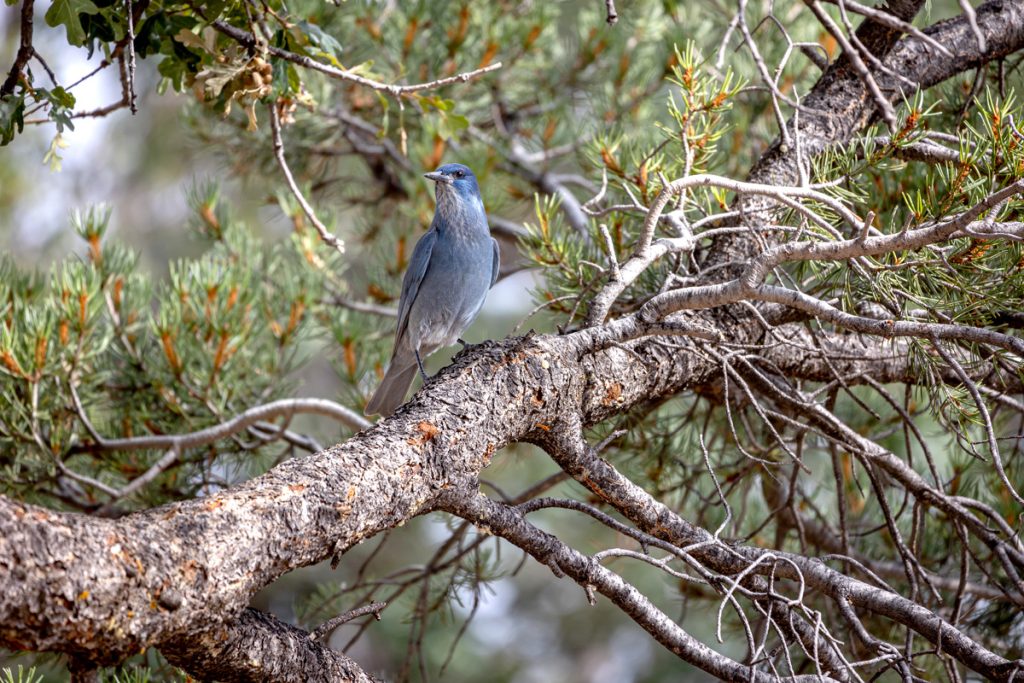
A new visitor is curiously inspecting the bird feeder I’ve just filled. A grayish-blue cloak of feathers beneath a bright indigo cap, not without reason they’re called blue crows. It’s a Piñon Jay, and he’s digging past the millet filler to get to the scrumptious seeds he craves. I send a telepathic apology to him for skimping on the bird food this month, as he’s come to expect black sunflower seeds and even nuts and fruit at this location. Like all the avian visitors that grace my yard, I treasure the opportunity to see him up close and personal, not behind museum glass or an LED-lit screen. I treasure this scene not just because they are beautiful creatures with cute, gregarious attitudes and quavering, high-pitched caws, but because I may one day live in a world where I can only see them behind a sterile screen or a museum.
The Piñon Jay population has declined 84 percent in the last 50 years. Without protection they are on track to lose half their population by 2035. Conservation group Defenders of Wildlife recently petitioned the Fish and Wildlife Service to protect Piñon Jays under the Endangered Species Act. The New Mexico representative of Defenders of Wildlife, Patricia Estrella, notes a “suite of factors including removal of its piñon-juniper habitat, drought, and climate change” that threaten the species.
These jays have a symbiotic relationship with piñon trees, which provide them with homes and nourishment through pine nuts. Jays inadvertently plant new trees when they forget where they left a cache of nuts. Retired UNM biologist Kristine Johnson recently described the seeding capabilities of Piñon Jays in an article for Undark, explaining “their esophagus expands to store up to 50 nuts, and since they’re highly social, one flock can plant millions of seeds in a fall season.” Piñon Jays have an exceptional memory and recover 95 percent of the seeds they store away, the remaining 5 percent go on to become new piñon trees.
Johnson continues by noting the double-edged sword of this relationship: jays become dependent on a “mast crop,” an irregular cycle where Piñons produce an abundance of seeds. These extra seeds go into storage until the following spring when they’re used to feed offspring. But under severe drought, these mast crops cannot happen, and Piñon Jays will not have adequate resources to nest and reproduce.
Piñon pines themselves are on the decline. A study published in August 2022 by Global Ecology and Biogeography found that 4 out of 5 juniper tree species are losing range in the West. In Nevada Today, University of Nevada, Reno researcher Robert Shriver explained, “The areas where the Piñon Jay tends to choose are on that border of the sagebrush and the piñon. It likes those habitats that are probably the most vulnerable.” This concurs with Johnson’s observations of Piñon Jay nesting habits- “jays tend to place their nests in larger trees in areas with dense canopy cover and low levels of recent disturbance,” going on to say these specific habitats are “surprisingly scarce.”
Shriver noted the importance of Piñon/Juniper trees beyond providing habitats for jays and other animals. Their nuts are a culinary staple in Native American and Hispanic cultures, and the trees themselves play a crucial role in water retention and erosion prevention. He gives a grim forecast of what’s to come if radical action is not taken to preserve these trees: “a lot of places where we saw forests, we may not see them, especially in lower elevations, because they tend to be the hottest and driest.”
Shriver offers hope: “…results also suggest that for some locations, management actions could slow down or reverse the woodland declines.” The loss of forestscapes is not solely due to drought. Deliberate destruction and clearing of these forests play a large role. Bryan Bird, Southwest program director for Defenders of Wildlife, told Undark that piñon-juniper woodlands “have long been maligned as having no economic value, and targeted for removal by private, state, and federal managers in favor of grasses for livestock.”
Wildfire prevention is another reason given for the clearing of piñon forests, despite studies, such as one published in The Condor, finding that “tree reduction treatments in piñon–juniper woodlands have the potential to reduce habitat quality for a suite of bird species of conservation concern.” Defenders of Wildlife and other conservation groups are challenging the implementation of the Biden administration’s approach to wildfire prevention, which calls for $1.5 billion evenly divided between prescribed burns, mechanical tree harvesting and fuel breaks (a fuel break is a strip of land that is altered to slow down an encroaching fire, for example by replacing native grasses with invasive weeds).
Fuel breaks have been criticized for their ineffectiveness, not just by environmentalists but by the Forest Service itself, which noted in a 1977 handbook that “a strong criticism of the fuelbreak approach to fire control is that the headlong rush of a large fire can carry it across a wide break — manned or not — under extreme conditions.” Defenders of Wildlife worry that these drastic measures will be carried out without consideration of public input or environmental impact studies.
As it stands, the Fish and Wildlife Service (FWS) will determine if the petition from Defenders of Wildlife has enough information to warrant a review of the Piñon Jay and its habitat, which could take months. In an email to Undark, a representative for FWS cited “little data on the effects of management on jay populations,” and said, “We are exploring the effect of the removal of pines and junipers” to reduce wildfire risk in order “to determine if these contribute to short term causes of decline.”
The Piñon Jay situation is not hopeless. National Public Radio recently interviewed Corina Newsome of the National Wildlife Federation about the rebounding of wetland-based birds. When asked why waterfowl populations are growing as all other bird populations decrease, Newsome gave a simple explanation: “[it’s] a result of investment in conservation targeted to help increase the population of birds like ducks[…] those birds that live in wetland environments are a clear indication that when we put our minds to it and our money to it, conservation can work for birds.”
It’s a concept that may take time for some bureaucrats to understand, but yes, believe it or not, putting resources into the conservation of birds conserves those birds.
If you want to help protect Piñon Jays and the forests they call their home:
Piñon jays love sunflower seeds, peanuts, cracked corn and suet. A backyard feeder gives them a reprieve and gives you a chance to see their beauty. Piñon Jays were once in the millions, now in the hundreds of thousands. If we do not act, they may one day be only in memories.
Consider participating in the Piñon Jay Community Science project with the Great Basin Bird Observatory. You can sign up and record sightings of Piñon Jays on the Great Basin Bird Observatory website.
Defenders of Wildlife suggests urging federal, state, and local agencies to adhere to the New Mexico Avian Conservation Partners guidelines for forest management. These guidelines include scheduling thinning around nesting Piñon Jays, buffering habitats around breeding colonies and leaving untouched patches of piñon and juniper trees. You can read the full pamphlet at AvianConservationPartners-NM.org.
Contact numbers for relevant agencies are as follows:
U.S. Fish and Wildlife: 1-202-208-5634. You can email them via their website or send mail to 1849 C St., NW Washington, DC 20240
U.S. Forest Service: (800)832-1355. You can also email them through their website.
U.S. Forest Service, Southwestern Region: (505) 842-3292.
Mailing address: 333 Broadway SE, Albuquerque, NM 87102 United States
Bureau of Land Management, New Mexico: (505) 954-2000.
Email: blm_nm_comments@blm.gov
Mailing address: 301 Dinosaur Trail,
Santa Fe, NM 87508
Author
-

Bryce Flanagan moved from Sacramento, CA to Taos County in 2016, and has lived in Questa for two years. He's passionate about the unique and beautiful wildlife of our state and is a regular contributor to the Questa Del Rio News.
View all posts



